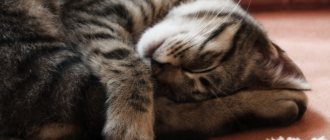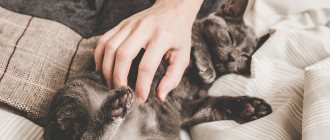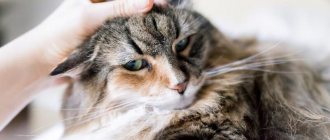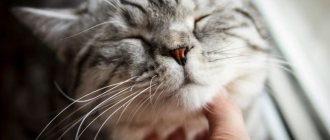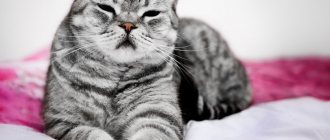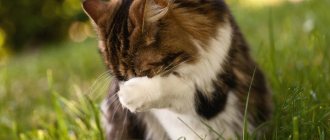Man did not domesticate the cat. Since ancient times, these cute, furry creatures lived with people side by side under the same roof. Cats brought comfort into the house and protected homes from mice and other small rodents. But for many centuries, cats have raised many questions for humans, the answers to which are difficult to obtain. One of the most interesting is: why do cats purr and how do they do it? For many decades now in various countries, scientists have been trying to answer this question. And here are the conclusions they came to:
Purring phenomenon
Throughout the history of mankind, the cat has accompanied us. Tens of thousands of years ago, the inhabitants of the Middle East tamed the wild steppe cat, and since then it has become a symbol of the hearth and home.
Due to its special unusual sound, in ancient times this animal was a symbol of fun and play, but in the Middle Ages the mysterious essence of purring began to be considered devilish and sinful.
Modern cat lovers know that their songs are not sent from heaven or hell, but are the result of a physiological process. It is not entirely clear which organ is responsible for sound; only one thing is clear – sounds are produced consciously and controlled by the animal itself.
Physicists have discovered that a cat's body emits electromagnetic impulses that produce loud or quiet sounds. They are beneficial for animals and humans, have a healing effect and bring peace and tranquility to the atmosphere of the home.
Where does this unique sound come from?
Despite a long study of this issue, it is difficult to clearly determine the reasons, but nevertheless, the main situations in which a cat begins to purr have been established.
As soon as they are born, blind and helpless babies find their mother precisely by this sound, so she calms them down and notifies them of her presence. Thanks to this, the kitten can determine where its treasured source of food and drink is, and the mother cat, hearing the purr of her cubs, remains calm about their health and mood.
The cat begins to make rhythmic sounds in those moments when he really feels good and his emotions are just going off scale, for example, on the owner’s lap. Substituting his soft belly and ears under his hands, the pet starts his little motor and cannot stop for a long time. Try scratching your pet behind the ear and you will understand why cats purr when you pet them. A smile of pleasure and delight literally spreads across the fidget's face.
The mechanism of sound production when purring
Some scientists put forward their theories about the source of rumbling, offering the following options.
Vocal cords are used by cats to meow, which humans hear when the animal makes the sound with its mouth open. If it is closed, then the vibration, which occurs due to the same work of the ligaments and throat, touches a special bone located under the tongue.
The sinuses increase vocal resonance. When an animal's mood changes, the speed of blood flow increases, that is, a change in blood pressure occurs. Vibration of the chest causes vibrations, which are converted into sound in the sinuses.
The involvement of the lungs in the process was established through observation of animals: purring is not the same when inhaling and exhaling.
What are the benefits of a cat's purring for humans?
A cat in the house is a living anti-stress. In any case, many owners are sure of this. Indeed, the purring of an animal is very calming and even lulls you to sleep. But cats are also real healers. Let's list what miracles they can create only with the help of their purrs, based on research by Californian scientists:
- Cat sounds, usually made at a frequency of 27-44 Hz, help strengthen bone tissue;
- Frequent communication with domestic cats is indicated for people suffering from nervous disorders;
- Regular listening to cat songs helps strengthen the immune system, which means it prevents frequent illnesses;
- The sounds of purring improve a person’s cerebral circulation, normalize blood pressure, and calm a rapid pulse;
- The purring of cats can help people addicted to alcohol or drugs to go through the rehabilitation period more easily;
- Purring pets treat gastrointestinal diseases of their owners (gastritis, colitis, stomach ulcers, etc.);
- If, while purring, the cat also releases its claws, this can be regarded as an almost full-fledged acupuncture session (claw therapy has an anti-inflammatory effect on the body, cures gynecological problems, stabilizes blood pressure, relieves swelling and improves skin condition, promotes weight loss, etc.).
Well, truly, a cat’s purring is beneficial for humans. Not only is cat singing itself therapeutic, but scientists have also proven this: children who live in the same apartment with a cat are less likely to develop asthma. It is believed that animal allergens have a preventive effect on the development of respiratory ailments in children, provided that the child communicates with a cat from an early age (up to 2.5-3 years). In addition, happy owners of cats live on average 4.5 years longer than people who do not have purrs or other animals in their homes.
Are only cats able to purr?
It is widely believed that purring is a privilege of the feline family. Indeed, each of its members, regardless of size, can make similar sounds, but in large representatives they are more like a roar and roar.
However, there are many species in the animal kingdom that have a similar ability. For example, species related to cats are cat-like hyenas and civets: mongooses, genets, civets. In a good mood, foxes and badgers, guinea pigs and squirrels purr while eating. Gorillas and sometimes even elephants rumble quite loudly.
Reviews from owners about the purring of cats and cats
I have a peacemaker cat. As soon as someone raises their voice or starts screaming, she jumps into the arms of the one who is talking loudly and starts purring like a tractor. Everyone immediately laughs and no one swears anymore.
Marie
https://www.woman.ru/psycho/medley6/thread/4343692/
My cat fell from the 5th floor about 2 months ago. I sat in the basement for 2 weeks (I couldn’t find her). Now she runs, plays, eats a lot (before the fall she ate little), but she also constantly purrs, as if she was roaring! Previously she was very silent, you couldn’t hear a sound, but now it’s impossible to tolerate. He doesn't cry only when he sleeps.
matata
https://www.veterinar.ru/forum/viewtopic.php?id=2775
A week ago I bought a kitten that was taken from my mother. If I approach her when she is sleeping, she wakes up and purrs (caress me) and at the same time meows terribly (let me sleep!) Maybe she’s calling her mom? The rest of the day he behaves normally, as if he doesn’t know his mother. why is she acting like this
Sofiko
https://forum.kotodom.ru/topic2393.html
Causes
The first reason is pleasure. Kittens purr from warmth and satiety, adult cats purr from the affection of their owner. Animals show it not only by sound, but also, for example, by releasing their claws.
In addition, there are a number of other factors that can trigger purring:
- Demand for attention.
- Request for food.
- Relieving stress and pain, for example, during childbirth or severe wounds, fear.
- Expression of gratitude.
- Acquaintance.
- The joy of hunting.
Scientists' opinion
Zoologists believe that the occurrence of purring is primarily associated with motherhood. With this sound, the mother calms the babies, lets them know that she is nearby, and can also warn of danger.
In addition, researchers from the American Stanford Institute found that purring helps strengthen bones.
A pet's sedentary lifestyle, which spends most of the day sleeping, does not affect the health of the musculoskeletal system precisely because of this ability: vibration restores musculoskeletal activity.
How is a cat's purring beneficial for humans?
Scientists have proven that the purring of cats has a beneficial effect on human health. Pets help with sound therapy:
- restore bone tissue of the human body;
- calm and calm people during times of stress and in the presence of nervous disorders;
- improve cerebral circulation and reduce the risk of stroke;
- reduce blood pressure, normalize pulse;
- reduce the risk of heart disease.
The process when a cat purrs while moving its paws and releasing its claws has been compared to acupuncture.
If a child grows up next to a cat, then he is less likely to develop asthma. The fact is that when children under 3 years of age constantly communicate with animals, this helps to build immunity to respiratory diseases, including asthma. Since cat saliva and fur contain allergens, with regular exposure they help build resistance to the disease.
Purring as communication
Depending on the timbre and volume, the purring of one cat may indicate a demonstration of a social role in front of another. A quiet purr speaks of friendly and peaceful thoughts: for example, a cat thus shows the cat its defenselessness. Loud is a manifestation of dominance.
Many owners note that if someone in the house is sick, the cat will certainly purr supportively over the sick person.
A person is perceived by a pet as an equal member of the pack. A purring pet shows the household its affection, gratitude, or asks for affection. If a cat with a raised tail purrs loudly and sparkles its eyes at a guest or a new thing, this means a demonstration of hostility.
Cats communicate using purring
Often, purring sounds help the cat family communicate with each other. The quiet purring of cats indicates that they are friendly towards the animal and encourage it to become a participant in their games. A loud purr positions the cat as a strong, dominant animal. Thus, a cat can show its relative that it is stronger, so it is pointless to engage in battle with it; it also means that a weaker cat need not be afraid, since no one will attack it. Purring sounds can also indicate that the cat is completely defenseless and asks not to be harmed.
With the help of purring, cats can heal each other , so it was noticed that if one of the felines feels bad or is sick with something, another cat comes and purrs, calming and encouraging him.
No less interesting is observing the relationship between a cat and her cubs. Kittens, by purring, give a signal to the mother cat that they want to eat or have eaten and are now completely full. Particularly funny are the moments when kittens eat their mother's milk and quietly purr with pleasure. Hearing their mother purr, the kittens feel completely safe while eating milk. Purring is a mother's signal when she is approaching the den of her cubs. By purring, she lets the kittens know that everything is fine and they don’t have to worry about anything, because mom is already nearby.
Purring as a stress reliever
Veterinarians say that the process of purring helps a cat cope with pain. Vibration relieves tension from the muscles, from which blood flows to the brain, which helps to quickly calm the pet.
For example, cats purr especially intensely during childbirth. This helps them not only calm down, but also breathe correctly.
If the owner needs to provoke purring, it is recommended to stroke the area of the neck, belly, and back.
The benefits of purring for people and cats.
Science has put forward several theories in this regard.
- 1. The effect of vibration and the sound of purring produces a certain hormone in cats, which acts as an analgesic and relaxing effect on the animal’s brain;
- 2. The vibration of the rumbling has a certain frequency, which strengthens the animal’s own bones. Perhaps this is why wounded or sick cats purr. Even during sleep, the animal’s bones and muscles are in good shape;
- 3. For humans, the purring of a cat can also be a good medicine. The frequency range of the rumbling is from 21.98 Hz to 23.24 Hz. It is in this interval that medicine uses means to strengthen human muscles and bones;
- 4. Strengthening the nervous system is another healing property of cats. This Sound has the property of calming the human nervous system.
It's no surprise that the feline family is one of our favorite pets. Who love to cuddle up to their owners and are exemplary house pets.
The therapeutic effect of purring
Experienced owners say that cats sense illness, and if the pet always sits on its stomach or chest, you should consult a doctor.
Psychologists distinguish such a concept as feline therapy - a method of treating or preventing various diseases through contact with a cat. Its effectiveness has been confirmed by numerous experiments.
Thus, American scientists have found that when a cat purrs, a person’s blood pressure and pulse normalize. And Russian zoologists have found that cat owners, according to statistics, live several years longer and suffer 20% less from problems with the cardiovascular system.
Today, feline therapy is especially popular for the treatment of diseases such as depression, anxiety, irritability and stress, and migraines.
Why your cat doesn't purr and what to do about it
Is it possible to make a cat purr? No, especially if she is not naturally inclined to do this. And that's okay: not everyone feels the need to express emotions by purring. There are even breeds that are not inclined to turn on their “engines” - Ragdolls and Devon Rex. Here, again, there are exceptions.
Getting a purr to do anything is very difficult in general, and with purring and other ways of expressing emotions it is even more difficult. This partly explains the impossibility of accurately diagnosing the mechanics of the appearance of iridescent sounds in predators. Nobody wants to purr in an MRI machine or during an ultrasound.
Sometimes this “insensitivity” is related to previous negative experiences. If the cat has been with bad owners or on the street, it may simply be afraid to show emotions by purring. You can try to help your cat make the desired sounds. Play with her, caress her, introduce treats into her diet (always natural) and demonstrate by your behavior that you are a safe person.
Mr. Cat recommends: interesting facts
Purring is a process unique to the animal world. But among the purring ones there are their own records:
- The volume of the rumbling varies in the range from 16 to 100 dts.
- The English cat Merlin purrs four times louder than an ordinary pet. The sound is so loud that it drowns out a running hair dryer. Eyewitnesses compare the cat's purring to the sound of a landing plane.
- The kitten makes its first “murr” at the age of two days.
- The most “purring” country in the world is Australia, where there is a cat for every resident.
1111
Ways to understand your pet
Each animal has an individual character. Additionally, sociability varies by breed. Siamese cats are considered the most talkative. The good-natured British also love to purr. Experts say that the human ear is able to recognize 16 vocal signals that a cat gives. A kitten that has reached the age of 3 months already has a full vocabulary.
To learn how to communicate with your pet, you need to carefully listen to her intonation:
- Purring, similar to a lullaby, usually indicates a benevolent mood, peace, and satiety. In this way the cat shows its good attitude towards its owner.
- Uterine sounds, which may alternate with hissing, mean fear or rage.
- A typical greeting for pets is a single or multiple meow in high tones, turning into a purr.
- Purring, accompanied by a sharp, demanding meow, can mean a complaint or request: this is how a cat behaves when they are hungry or trying to get a tasty morsel from the owner’s table.
- A loud, prolonged meow accompanied by rumbling is a call for help or a symbol of anger. The cat may be scared or in pain.

